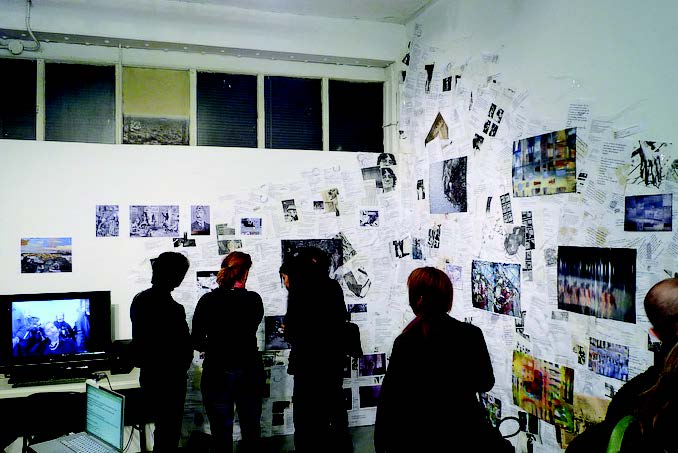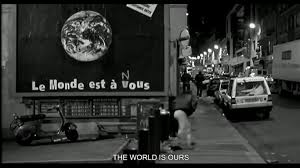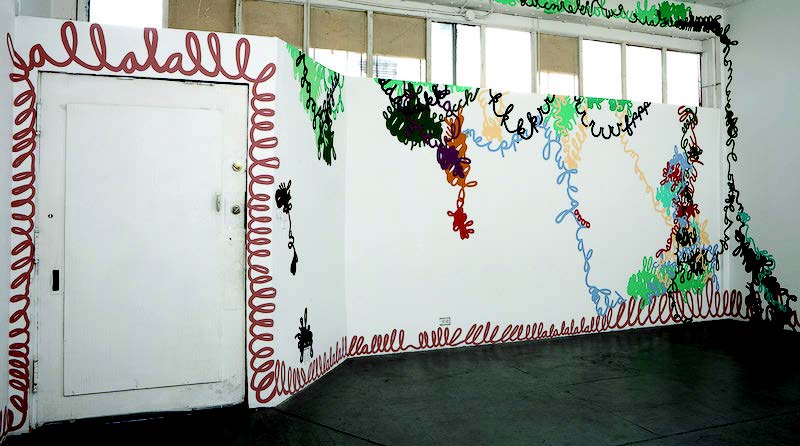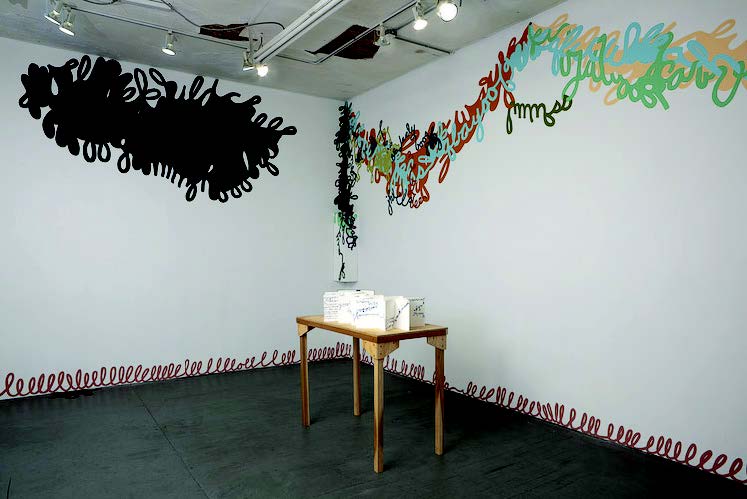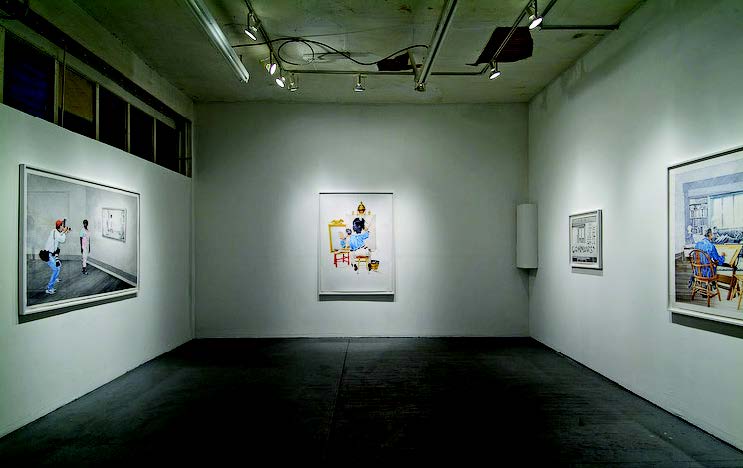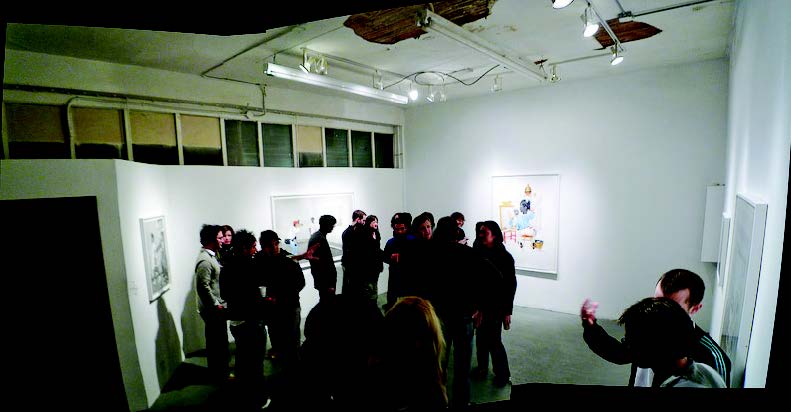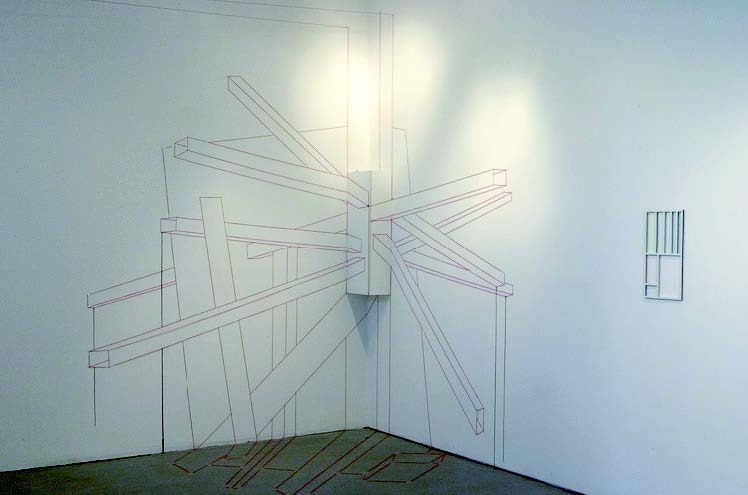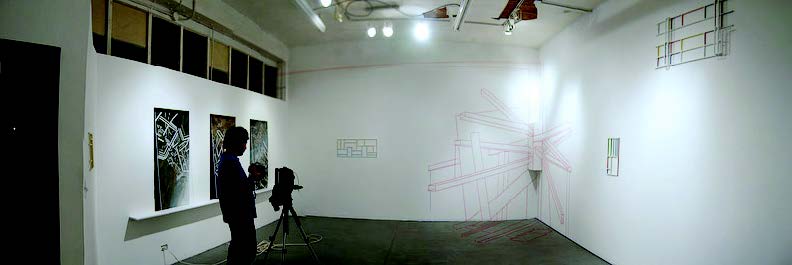Monte Vista Projects is proud to present Terra Firma, the first solo exhibition of Los Angeles based artist, Michael Kontopoulos. The exhibition runs from January 19 to February 10, 2013. The opening reception is Saturday, January 19, 7-10pm.
The work in this exhibition borrows strategies from speculative fiction and design in order to explore themes of escapism, the frontier and the illusion of utopia. In collaboration with graphic designers and 3D computer modelers, Michael has fabricated a series of artifacts that contrast the obviously fictitious with the ambiguously realistic and uncanny in an effort to anticipate the political imaginary of abandoning the Earth.
Through print design, sculpture and installation, the works in Terra Firma explore several ideas including the visual vernacular of how rovers and satellites (themselves, unique sculptures) "see" their environment and therefore, how we experience the unknown through them. In addition to this, Michael is utilizing the strategies of graphic design branding campaigns to envision boarding passes for impossible destinations.
At once an imagining of a potential future and a lamentation for an unsatisfactory present, this work investigates space exploration and space tourism as an adult concretization of a childhood need to be subsumed by fantasy.
Michael Kontopoulos is a Los Angeles based artist and educator. After studying electronic and time-based art at Carnegie Mellon University, he went on to receive his MFA in Design and Media Arts from UCLA.
He has exhibited solo and collaborative projects in galleries, festivals and conferences in the U.S., Asia and Europe, including the Santa Monica Glow Festival, the Sundance Film Festival, and the TED conference. He was the winner of a 2010 Rhizome Commission for Emerging Artists, sponsored by the New Museum (NYC). Currently, Michael teaches electronic media courses at USC, UCLA, Cal State Long Beach and Art Center College of Design.
www.mkontopoulos.com
Minimum Yields Maximum
February 20 - March 20, 2010 Opening Reception February 20, 7-10 pm
Minimum Yields Maximum curated by Gina Osterloh MM Yu, Roya Falahi, Yason Banal, Ringo Bunoan, Joshua Callaghan, Kent Familton, Louie Cordero, Hong-An Truong, Reanne Estrada, Poklong Anading, Lena Cobangbang, Gary-Ross Pastrana
Monte Vista is pleased to announce Minimum Yields Maximum, a group exhibition curated by LA-based artist Gina Osterloh, featuring work by artists from the Philippines, Vietnam, and Los Angeles. Along with the exhibition, Monte Vista will host a book release event for Sarita See’s (Asian/Pacific Islander American Studies, University of Michigan) new book The Decolonized Eye: Filipino American Art and Performance. All of the author proceeds will go to the environmental justice organization FACES (Filipino American Coalition for Environmental Solidarity).
The artists in Minimum Yields Maximum work through a conceptual lens that considers everyday materials, and often engages greater social inquiries—a type of art practice that is both wide-ranging and inclusive. Many of the artists from the Philippines have studied and/or collaborated with artist and teacher Roberto Chabet. Perhaps this exhibition is a reminder that the Philippines has never hailed a singular geographical identity. It is also an appeal to shift art history, to consider a conceptual and political art model that includes the Pacific Rim. Most importantly, as an artist I have felt a strong resonance between the selected works from Manila and those from the United States. The works in this exhibition refuse to be easily identified or placed geographically. Instead, they build upon structures of loss, humor, rupture, trauma, and obliteration.
In the 1970’s, during the Marcos Regime in the Philippines, a strong conceptual art movement began in Manila. Led almost singlehandedly by Roberto Chabet, this movement took a strong stand against representational landscape painting, Social Realist murals adhering to strict aesthetics, and Modernist soft-brushstroke paintings popular in post-WWII Philippines—in short, a move to reject an essentialist identity and a simplistic art historical model of Philippine art. From the 1970’s to the present, artists scattered throughout the world have become actively involved in a dialogue with Chabet through travel, arts grants to Manila, and especially through the artist community that he has mentored.
In the beginning, Chabet’s work was affiliated with the Cultural Center of the Philippines (the CCP) as founding museum director of the CCP. A large Modernist building created by Imelda Marcos, the CCP stands out as a formidable floating cube looming over Roxas Boulevard along Manila Bay. After his departure from the CCP in 1971 due to internal politics, he began teaching at the University of the Philippines, and in 1974 founded a conceptual art group called Shop 6—the first alternative artist-run space in Manila. Subsequent alternative venues such as Agnes Arellano’s Pinaglaban Gallery in the 80’s, and Big Sky Mind and Surrounded by Water in the 90’s and today, all credit Chabet as their inspiration. As an artist himself and mentor to artists since the 70’s, Roberto Chabet has defiantly pushed forward a type of “inclusive conceptualism”1—which has influenced hundreds of art students at the University of the Philippines where he taught until recently, as well as other artists who have met Chabet and experienced his generosity in person.
In the Philippines in particular and Asia as a whole, artists from Manila are well known through their participation in biennials throughout Asia, recognition awarded through the Cultural Center of the Philippines and Ateneo University, the surge of commercial galleries representing their works throughout Asia, and the insistence of independent art spaces such as Green Papaya Art Projects in promoting an international dialogue supported by institutions such as the Asia-Europe Foundation and Arts Network Asia. Other cross-national arts ties in the Philippines include the French Embassy, Alliance Française, and the Goethe-Institut.
Due to the lack of consistent institutional support for the arts between the Philippines and the United States—especially when viewed in comparison to relations between France, Australia, or Germany and the Philippines—independent, artist-run spaces such as Monte Vista are of the utmost importance and urgency to make exhibitions such as Minimum Yields Maximum a possibility.
—Gina Osterloh, February 2010
1Ringo Bunoan, text. Ringo Bunoan has been a constant wealth of historical background for conceptual art practices in Manila. As with many of the artists in this exhibition, we shared many late night conversations during my Fulbright
grant in Manila 2007-2008. She recently exhibited here in Los Angeles at REDCAT for the exhibition Everyday Miracles
(Extended).
Mirjam Dröge Artist Talk
January 31, 2010, 6pm
Mirjam Dröge Artist Talk In conjunction with The Need to Hold Still at UC Riverside/California Museum of Photography
MIRJAM DRÖGE
Ah-round
January 9—February 6, 2010
Opening January 9, 2010, 7—10 pm
Rebecca Ann Hobbs
Monte Vista is pleased to announce our first exhibition of 2010, featuring Ah-round, a single channel video by Australian artist Rebecca Ann Hobbs. About the work, Hobbs says:
Ah-round was made in the summer of 2008, during which time I was involved in a romantic relationship with Madou, the man in the video. Madou and I endeavored to make a work together that celebrated our shared experiences in spite of our apparent differences. He is from Mali and has been living in New Zealand for almost fifteen years now. I, the woman behind the camera, am from subtropical rural Australia and have been in New Zealand for about four years. Mali is a land-locked West African country, whereas New Zealand is an island in the South Pacific. Madou, confident in front of the lens, and I, preoccupied with the lens-based medium of video, realized that it was only natural for us to make a moving image piece together, yet we were also acutely aware of all that we represented as people and how that would affect the reading of the work. We decided that it would be best to confront our concerns candidly, whilst trying not to be too inhibited by the histories that separate us.
The images in Ah-round are quite literal. They intentionally appropriate iconography found in Romantic representations of the “Other.” These images support an Imperial power structure by incorporating motifs that reinforce existing stereotypes. In this instance, the “Noble Savage” is located in the exotic and faraway Pacific jungle. However, this particular “jungle” is made up of potted plants and exists in an overtly constructed space, a greenhouse. There are also satellite dishes, urban brick houses, a polo shirt, and a manmade ceiling—elements that intrude upon our idea of an untouched wilderness. Ah-round is intended as a parody; Romantic conventions are lampooned in order to make them seem ridiculous.
This work is founded on my research into Edward Said’s Culture and Imperialism. Of particular interest to me is the idea of the active subject. It was important that Madou was actively negotiating the situation, an independent being, in charge of his circumstances. I have also been researching Marcus Garvey’s work and his supporting ideologies. Garveywas an advocate of Pan-Africanism and he established a shipping company called the Black Star Line. The BSL functioned as a business, as Garvey believed that empowerment could be achieved via financial security, but it was also a logistical strategy to move black people who were victims of the diaspora back to Africa, the Motherland. Financially, the BSL failed in the end, but the power of Garvey’s ideas have remained. The 360-degree camera movement of Ah-round represents the idea of moving full circle and pays tribute to Garvey’s BSL ambitions. The song that Madou is listening to is “Traveling,” by Burning Spear, from the album “Spear Burning.” Burning Spear, also known as Winston Rodney,cites Garvey’s philosophy as a major influence in his life.
Said, Edward. Culture and Imperialism. Vintage, 1994. Grant, Colin. Negro with a Hat: The Rise and Fall of Marcus Garvey. Oxford University Press, 2008. Nelson, Stanley. Marcus Garvey: Look for Me in the Whirlwind. 2001.
Hey Man, You're Saved
November 21- December 6, 2009 OPENING November 22, 2009, 5–8 pm
Public Dialogue - Wednesday, December 2, 7-9:30 pm
Monte Vista is proud to present Hey Man, You’re Saved, a group exhibition of new work by nine insightful and diverse artists from the USC Roski School of Fine Arts. Operating between the ideal world of the concept and the structured site of the gallery, the work of these artists manifests through different mediums to explore appropriated sound and imagery, photographic process, fantastical and constructed landscapes, and the flux of identity. Hey Man, You’re Saved. So come in and be rescued from the monotony of visual consumption. Let’s get saved!
Please join artist Sydney Mills and American media scholar Henry Jenkins, for Whiz, Bang, Shimmer, Pop: The Rise, The Fall and The Future of The Video Game Arcade. Together with audience members, Mills and Jenkins will examine the transformation from epicenters of the vibrant, budding gaming subculture of the early 1980’s into modest communities struggling to keep their doors open.
Refreshments 8-8:30
Henry Huang, a long term Jesus People member and his artist / engineer daughter, Hannah Huang, will discuss Birth and Rebirth: The Jesus People in Community. The Jesus People USA is one of the few intentional Christian communities remaining today, situated near uptown Chicago. Topics include street witnessing, sustainable communal living, and the deep rooted subculture that results from this dynamic existence.
The Peninsula
October 3 – October 31, 2009 OPENING October 3, 2009, 7 – 10pm
Antoni Wojtyra
Monte Vista is pleased to announce Polish/Canadian artist Antoni Wojtyra’s first solo exhibition in Los Angeles.Wojtyra’s work is elusive, defiant, and humorous. Operating at times like an itinerant worker,Wojtyra moves fluidly from subject to subject, with a varied practice emphasizing concisenessand utility. Wojtyra uses books, discussions, photographs, line drawings, paintings, text, etc. tounhinge conventions and stereotypes—creating spaces for the reimagination of alternatives.Wojtyra’s exhibition at Monte Vista promises to surprise yet again as he proposes that artconform to an ecologically-sound, sustainable ecosystem. While material culture strivestowards a clean, green, and biodegradable ideal, art continues towards an art that is timeless,classic, reverent, and archival. For this exhibition, Wojtyra was inspired by a migrant strategyof condensing material wealth into diamonds, sewn into the hemlines of clothes, smuggledacross borders, only to be sold and converted back into a new life, and possessions, in a new settlement. Using this pragmatic, light, and supremely wise “immigrant logic,” Wojtyra reimaginesthe gallery space as a peninsula, commingling and testing Art’s effect and power in relation to*terra firma*, the street.
Game Night at Monte Vista
Where: Monte Vista, 5442 Monte Vista St., Los Angeles, CA 90042 When: Thursday, September 17, at 8:00pm
Why: FREE SNACKS! And GAMES!
CORPORATE LADDER is a strategic game of stacking blocks for 4 to 6 players. The object of the game is to take up the most space.
GIVE AND TAKE is a game of scrimmage for 2 players. Think checkers meets Chinese finger trap.You can find out more about Corporate Ladder at:
http://hadto.net/category/projects/corporate-ladder
Until We Come to One that Reminds Us
Opening Reception August 8, 7–10 pm
Until we come to one that reminds us
Paintings and sculpture
Kristina Faragher, Christine Frerichs, Amy Green, and Curt LeMieux
Until we come to one that reminds us is an exhibition of four artists whose works reflect an
engagement with materials in a landscape of personal and political trouble. Kristina Faragher, Curt
LeMieux, Amy Green, and Christine Frerichs use materials as surrogates for body, place, psyche,
and the gap between emotion and language.
The paintings and sculptures in this exhibition suggest a substratum of guilt and loss in American
psychology, the unease of belonging to a nation engaged in imperialist wars that have not
ceased despite popular objection. The works subtly couple a domestic sensibility of the brutal
landscape of war in a queasy interplay of long-time American themes.
Kristina Faragher’s hundreds of small, craft-store balsawood “keepsake” boxes are strategically
smashed, reconstructed, and enameled with painstaking attention to detail. The pieces are then
forced back into the boxes, no longer able to contain sentiment. Faragher’s work suggests the
violence inherent in frustration at the limits of knowledge, cycles of violence and creation, and the
potential recuperation of those who have been disfigured and forced back into a cultural system
that must contend with them.
Christine Frerichs uses charged materials—active carbon, cement, dirty turpenoid—in order to call
up the penetrable split between the conscious and unconscious and the personal and cultural
impact of repression. Images are cultivated on the surface of her paintings to be immediately
rejected and wiped out. Some images are barely allowed to form, while others have been
laboriously plied. Frerichs rehearses the connection between personal and cultural conflicts,
between what is spoken and what is denied. The incompatibility of materials echoes the way in
which emotion and language disengage at the height of tension, neither being enough for the
other, both resonating apart.
Amy Green’s felt paintings delicately try the relationship between craft and abstraction. The
paintings recall metaphors of stain and place, of an uneasy bargain between surface and
support, and of the liminal space of the 70’s household, wherein women understood the murky
possibilities between liberation and reduction in the tight confinements of the physical world.
Green’s tentative placement of the frayed felt surfaces against the hard edges of the stretcher
bars belies a hesitation in the juxtaposition of craft against its heavy modernist counterpart.
Curt LeMieux’s sculptures and mixed media drawings allude to the witnessing of bodily trauma
within the tragedy of mediated warfare, linking barbarity to everyday cultural referents--remnants
of curtains, socks, pencils, and shoes. Materials are handled with a delicate aesthetic that opens
up a place into which the sense of both the disjunction and union of violence and security can
flow. Surveying LeMieux’s small drawings and sculptures, one has the sense of the viewer
as mute witness to a concatenation of banal and terrible events that have been reviewed,
acknowledged, and dismissed.
ARTIST AND CURATOR BIOS
Kristina Faragher, Artist
Kristina Faragher has exhibited works of art individually and collaboratively in a host of media
including video, installation, film, and performance. Selected venues and festivals include: The
Oakland Museum, Oakland, California; The Autry National Center, Los Angeles; The REDCAT
Theater, Los Angeles; Shoshana Wayne Gallery, Santa Monica; Track 16 Gallery, Santa Monica;
SITE Santa Fe, Santa Fe, New Mexico; LA Freewaves Ninth Annual International Media Festival,
Los Angeles; The Fifth Festival International de la Image in Colombia, South America; and
The Museum of Contemporary Art in Minsk, Belarus. Publications include: The Smithsonian
Institution’s Archives of American Art, Yosemite Art Of an American Icon (UC Berkeley Press), and
Extensions: Online Journal of Embodied Technology at UCLA.
Christine Frerichs, Artist
After receiving her B.F.A. from University of Arizona, Christine Frerichs lived in Brooklyn, then
moved to California to complete her M.F.A. at UC Riverside. She also attended the intensive
residency, Painting’s Edge. Her work has been exhibited in Los Angeles, Sacramento, Riverside,
Tucson, Boston, Chicago, and New York and has been published in the 2005 Northeastern
Edition of New American Paintings. Exhibitions include “New Work: Christine Frerichs,” Sweeney
Art Gallery, Riverside; Painting’s Edge, Riverside Art Museum; Works on Loan from the 21st
Century, Riverside Art Museum; and My Buddy at UCLA New Wight Gallery.
Amy Green, Artist, Curator
Amy Green received her B.F.A. in Painting from the University of Tennessee in 1995 and an M.F.A.
in Studio Arts from CalArts in 1997. Her paintings have been shown nationally and internationally
and appear in numerous private collections. Exhibitions include Rolf Ricke Galerie in Cologne;
the Neues Museum in Nurnberg; Galerie Monika Reitz, Frankfurt; Kunstverein St. Gallen in
Switzerland; Evelyne Canus Gallery, Paris; Cirrus Gallery, Susanne Vielmetter, Sea and Space
Explorations in Los Angeles; and Cohan Leslie and Browne in New York, among other venues.
Reviews include: New York Arts Magazine, Art Issues, the Basel Art Fair Catalogue, and Neues
Museum Catalog Essays. Recent exhibitions include “New Works” at 24Hr Gallery, “Let the trees
decide”, at Glendale College Art Gallery, and “Cosmos Factory” at Cirrus Gallery. Amy Green is
represented by Galerie Schmidt Maczollek in Cologne, Germany.
Curt LeMieux, Artist
Curt LeMieux received his B.F.A. in Painting in 1998 and his M.A. in Sculpture in 1999 from
the University of Wisconsin at Superior. He received his M.F.A. in Drawing and Installation in
2001 from the Claremont Graduate University. His works have been shown nationally and
internationally and appear in numerous private collections. Exhibitions venues and events include
The Museum of Contemporary Art in Minsk, Belarus; The Sixth Festival of International Images in
Manizales, Colombia; The Berkeley Video and Film Festival in Berkeley; The Santa Monica
Museum of Art in Santa Monica; Track 16 Gallery in Santa Monica; Los Angeles Contemporary
Exhibitions in Los Angeles; and Sea and Space Explorations in Los Angeles.
Asher Hartman, Curator
Asher Hartman is a painter, performance installation artist, and filmmaker. Hartman’s work
has been exhibited extensively in Los Angeles and elsewhere. Venues include the Whitney
Biennial in collaboration with Charles Long and Wilderness, the Cultural Center of the Philippines,
The Images Festival (Toronto), Recontres International (Paris/Berlin), and The Beijing Open
International Performance Festival. Solo and collaborative works in Los Angles include exhibitions
at Track 16, LACE, The Museum of Jurassic Technology, Highways Performance Space, Sea
and Space Explorations, and New Image Art. Hartman served as co-director of Crazy Space, a
gallery for experimental art and durational performance at the 18th St. Arts Center in Santa Monica (2000-2005) and teaches at the University of California, Riverside. He received a B.A. in Theater
from UCLA and an M.F.A. in Studio Art from CalArts.
Historical Vernacular
June 27–July 25, 2009
Opening Reception June 27, 7–10 pm
Melanie Nakaue and Wendy Red Star
Monte Vista Projects presents, “Historical Vernacular”, a two-person show by the artists Melanie
Nakaue and Wendy Red Star that investigates American cultural history, language and traditional
folk crafts.
Melanie Nakaue’s “Folklore” series is comprised of two single-channel animated videos and one
three-dimensional quilt block sculpture. The artist connects the dual role of physical and aesthetic
labor in her maternal and paternal grandmother’s lives, and examines how family histories are
preserved through folklore and folk crafts that reflect the daily histories and lives of working
women.
By juxtaposing analog (folk crafts) and digital (animation/video) forms the artist attempts to create
a discourse between representation, alternative narrative, history and aesthetic and personal
experience though animation, sound and sculpture.
Exhibitions of her sculptures, installations and video screenings include: Beloit College, Beliot, WI,
Portland Documentary and eXperimental Film festival, Portland, OR, Searching for Gold Mountain
Series, Alexander Gallery, Oregon City, OR, Un/Common, Pacific NW College of Art, Portland, OR,
The Armory Center for the Arts, Pasadena, CA; Supersonic, The Windtunnel, Art Center College
of Art and Design, Pasadena, CA; Gallery 4F, Los Angeles, CA, San Francisco Art Institute, San
Francisco, CA. Melanie was also selected for a public arts commission, Newhall Art Walk, in
Newhall, CA.
Wendy Red Star’s “The Crow Language Project” is both a website and series of non-web
presentations comprised of work made by Wendy Red Star in collaboration with Crow language
speakers. The project is geared towards creative ways to learn how to speak Crow. By using a
creative series of engaging exercises, videos, and interviews with Crow speakers Wendy Red Star
teaches herself and her two year old daughter how to speak Crow.
Wendy Red Star was born in Billings, Montana just outside of the Crow Indian reservation where
she was raised. She grew up in a multi-cultural family. Her mother is of Irish decent, her father a
full blood Crow Indian and her older sister is Korean. Wendy left the Crow Indian reservation when
she was eighteen to attend Montana State University in Bozeman, Montana where she studied
sculpture. She then went on to earning her MFA in sculpture at UCLA. Wendy currently lives in
Portland, Oregon where she is an adjunct professor of art at Portland State University.
Wendy Red Star’s work explores the intersection between life on the Crow Indian reservation and
the world outside of that environment. She thinks of herself as a Crow Indian cultural archivist
speaking sincerely about the experience of being a Crow Indian in contemporary society.
Her work has been shown at Helen E. Copeland gallery, Bozeman, MT, The Fondation
Cartier L’Art Contemporain, Paris, France, The CSULB gallery, Long Beach, CA, Research &
Development, Chicago, IL, The Museum Tower at MOCA, Los Angeles, CA, And/Or gallery,
Dallas, TX, The UCLA New Wight gallery, Los Angeles, CA, The L.A. Municipal Art gallery, Los
Angeles, CA, The Domaine De Kerguehennc, Brittany, France, The Hudson D. Walker gallery,
Provincetown, MA, The Plush Gallery, Dallas TX, The Laura Bartlett Gallery, London, England, The
Luckman gallery, Los Angeles, CA, and The Volitant gallery, Austin, Texas.
Amass curated by Dana Turkovic
.
May 9 June 6, 2009
opening reception May 9, 7 10 pm
Brandon Anschultz (St. Louis)
Sarah Baker (London)
Fantastic Nobodies (Brooklyn)
Iain forsyth and Jane Pollard (London) Robert Goetz (St. Louis)
Wendy Mason (Los Angeles) Erick Michaud (Austin)
Brandon Morse (Washington d.C.) John Watson (St. Louis)
Curated by dana Turkovic
Amass is an exhibition with multiple intentions and various definitions. First realized at Boots Contemporary Art in St. Louis, the exhibition’s second incarnation will respond directly to the space and mission of Monte Vista but will also maintain its original curatorial premise. The title is a reference in its most direct translation a metaphor for curating an exhibition; to gather artwork, to assemble ideas, to group, and to collect. The exhibition at Monte Vista will bring together
new video work from a selection of national and international artists. Under this headline, Amass is also blurring the boundaries between, art, design, and information by questioning the conventional configurations of how we view video art. By commissioning two artists to design “sculptural support” that invites, and in some ways, compels the audience to assemble and come together as viewers, the exhibition will aim to provide a series of smaller encounters within one collective social experience, thereby highlighting the existence of a ‘closed temporal loop’ between creation, interpretation and reception. This approach touches on Nicolas Bourriaud’s observations on what he coined “relational art”: “the audience is envisaged as a community. Rather than the artwork being an encounter between a viewer and an object, relational art produces inter-subjective encounters. Through these encounters, meaning is elaborated collectively, rather than in the space of individual consumption.” These experimental display interventions also set up a system for response and conversation within the work, providing
a complimentary transference between the space, the curator, the artists, and ultimately the viewer to develop through a sustained professional critique. By tweaking the dynamic, the challenge of this installation will aim to illustrate the possibility of complex associations that come together in one space, where video art and display connect, ultimately pinpointing and exploiting the meeting place between these art forms, the gallery space as social environment and collective spectatorship.
Tucker Stilley's The Permanent Record of Newjack Rasputin
April 10 April 25, 2009
opening reception April 10, 7 10 pm
Tucker Stilley
Walking the tenuous line between a “virtual residency” and an unsuccessful artificial intelligence test, multi-media artist Tucker Stilley pops the hood on his syncretic art-making process. Walking the tenuous line between a “virtual residency” and an unsuccessful artificial intelligence test, multi-media artist Tucker Stilley pops the hood on his syncretic art-making process. In a marathon 2 week session hosted at the Monte Vista Projects - Stilley, almost completely paralyzed with ALS (Lou Gehrig’s disease), demonstrates via live webcast & installation the method behind the creation of his on-going hyper-sigil artwork The Permanent Record of Newjack_Rasputin.
“I feel it is logical, my own nervous system failing, that I would spontaneously generate an alter- ego, tear a hole-in-space and try to escape. My situation warrants immediate and drastically uncompromising self-metamorphosis. An exquisite new aesthetic unfolds when you are standing on the deck of a burning ship. Being paralyzed amplifies the uneasy link between intent and action and brings into question the true meaning of this place and time that we occupy and of what our ultimate audience might prove to be.”
An artist for over thirty years, in as many media, Tucker Stilley 48, attended Studio for Interrelated Media, at the Massachusetts College of Art. He has worked in Boston, San Francisco, and Los Angeles as a media artist, sound designer and film editor. Previous exhibitions include ART, Cambridge, REDCAT & Octopus Garden Salon, LA.
This exhibition was curated by Sam Durant.
The Permanent Record of Newjack Rasputin
April 10 – April 25, 2009
Opening Reception April 10, 7–10 pm
Tucker Stilley
Walking the tenuous line between a “virtual residency” and an unsuccessful artificial intelligence
test, multi-media artist Tucker Stilley pops the hood on his syncretic art-making process. Walking
the tenuous line between a “virtual residency” and an unsuccessful artificial intelligence test,
multi-media artist Tucker Stilley pops the hood on his syncretic art-making process. In a marathon
2 week session hosted at the Monte Vista Projects - Stilley, almost completely paralyzed with
ALS (Lou Gehrig’s disease), demonstrates via live webcast & installation the method behind the
creation of his on-going hyper-sigil artwork The Permanent Record of Newjack_Rasputin.
“I feel it is logical, my own nervous system failing, that I would spontaneously generate an alterego,
tear a hole-in-space and try to escape. My situation warrants immediate and drastically
uncompromising self-metamorphosis. An exquisite new aesthetic unfolds when you are
standing on the deck of a burning ship. Being paralyzed amplifies the uneasy link between intent
and action and brings into question the true meaning of this place and time that we occupy…and
of what our ultimate audience might prove to be.”
An artist for over thirty years, in as many media, Tucker Stilley 48, attended Studio for Interrelated
Media, at the Massachusetts College of Art. He has worked in Boston, San Francisco, and Los
Angeles as a media artist, sound designer and film editor. Previous exhibitions include ART,
Cambridge, REDCAT & Octopus Garden Salon, LA.
This exhibition was curated by Sam Durant.
La Haine (Screening)
March 15, 2009
5 pm
Monte Vista presents a screening of Mathieu Kassovitz’s 1995 film
Film synopsis: When he was just twenty-nine years old, Mathieu Kassovitz took the international film world by storm with La Haine (Hate), a gritty, unsettling, and visually explosive look at the racial and cultural volatility in modern-day France, specifically in the low-income banlieue districts on Paris’s outskirts. Aimlessly whiling away their days in the concrete environs of their dead-end suburbia, Vinz (Vincent Cassel), Hubert (Hubert Koundé), and Saïd (Saïd Taghmaoui)—a Jew, an African, and an Arab—give human faces to France’s immigrant populations, their bristling resentment at their social marginalization slowly simmering until they reach a climactic boiling point. A work of tough beauty, La Haine is a landmark of contemporary French cinema and a gripping reflection of itscountry’s ongoing identity crisis.
Katie Lewis' Drawling Room
February 21 March 21, 2009
opening reception February 21, 7 10 pm
An installation by Katie Lewis
Monte Vista Projects is pleased to announce the opening of Drawling Room, an installation by Katie Lewis. After working with borrowed text for the last few years, Lewis has now turned her attention from noun to verb, focusing on the acting of writing rather than words themselves. The result is an installation of swooping, looping marks painted directly on the walls that suggest communication but refuse to make sense. One might wonder if galleries walls could talk, is
this what they would say? Punning off of the drawing room as a space of casual conversation and drawl as a relaxed, even stuttering form of speech, Drawling Room offers a wry appraisal
of contemporary information exchange. Ropey garlands of lazy language take their time with articulation and suggest that our continual quest for instant information gratification might in fact produce nothing more than nonsense. And maybe that really isn’t so bad.
Katie Lewis studied art and art history at Dartmouth College and NYU’s Institute of Fine Arts before completing her MFA at the California Institute of the Arts in 2005. She has exhibited her work at numerous venues in Los Angeles, such as 507 Rose, Harvey Levine Gallery, and JAIL. Her paintings were also included in the 2005 Greater L.A. exhibition at Cal State Long Beach and featured in an episode of the hit HBO series Entourage in the fall of 2008. In addition to painting, Lewis also writes about art occasionally and teaches in the art program at CalArts.
Phillip Maysles The Comfort of Enlightenment
January 10 February 7, 2009
opening reception January 10, 7 10 pm
Phillip Maysles
Monte Vista presents new works on paper by Philip Maysles. “The Comfort of Enlightenment” completes his engagement with Norman Rockwell’s iconic painting about desegregation, “The Problem We All Live With” (1964). Using the photographs Rockwell made of studio models for this painting as source material for new work, Maysles addresses the failure of white artists to undermine America’s racial hierarchy through a conventional studio practice. Maysles interprets and re-imagines the history of White artists’ relations to Black life and culture in order to articulate the way in which White masculinity is both affirmed and challenged through contradictory feelings towards its perceived Black other. Inspired by W.E.B. Dubois’ remark that, “White artists
. . . cry for freedom in dealing with Negroes because they have so little freedom in dealing with whites,” Maysles takes creative liberties with the master narrative of American art history to reveal the inability of Euro-American liberals to recognize how they are both complicit with and subject to violence perpetrated in maintaining White supremacy. By filtering this history through an artistic lens shaped by lived experience, personal feeling and an understanding of critical race theory, Maysles makes the racial dynamic of his own subject position visible.
Philip Maysles was born in and currently lives and works in New York City. He received his BA with honors from Brown University (2002) and MFA in Art from The California Institute of Arts (2005). Maysles has exhibited painting, drawing and installation at P.S. 1 Museum of Contemporary Art (Long Island City), Artists Space (New York), Project Row Houses (Houston), the Museum of Fine Arts, Houston, and The Amistad Center for Art and Culture at the Wadsworth Atheneum (Hartford, CT). His writing on art and music has appeared in Small Axe: A Journal of Caribbean Thought (Indiana University Press, 2001) and The CORE Journal (MFA Houston, 2006). He has been a lecturer in Art at Rice University and the University of Houston (2005-2007). He currently teaches documentary filmmaking and runs a non-profit cinema in Harlem, New York. This is his first solo exhibition in Los Angeles
Free Fall Perspective, Online and Perception
November 8 December 7, 2008 Opening Reception November 8, 7 10 pm
Ricardo Alzati, Diego Toledo and Alejandro Pintado
“Free fall perspective, on line and perception” is an exhibition that reflects upon the influence of systems in everyday day life, in particular it focuses on perspective. It analyzes the rational and logical way this system has to represent the three- dimensional space. Perspective is known as a system used to create the illusion of three-dimensional images and spatial relationships on
a two-dimensional surface. To accomplish this, there are a set of rules that should be followed. The vanishing point is the center from which the order should be placed; everything that is set out of this order is excluded from perspective. By having this apparently simple rule, all other possibilities are shot down. We tend to think that the system of perspective is only used for representation in a flat surface, on a two-dimensional flat object. The truth, is that the influence of this system has not stayed 2D, it has moved to the three-dimensional space. More than
ever two-dimensional images describe our experience of the world, this expressions affect the way we perceive our individual experience of the three-dimensional world. Perspective gives preference to the rational and logical order over the abstract and perceptual experience. Free fall perspective on line and perception questions the retinal experience and pushes the boundaries of what is expected to be seen. In the shape of light, shadow, line, paintings and drawings is that the artists Ricardo Alzati, Diego Toledo and Alejandro Pintado invite the viewer to move further away the expected rules enhancing his experience of abstraction of the physical space.
-Alejandro Pintado
This exhibition was made possible by ART2102
Ricardo Alzati was born in Mexico City in 1974. He received his education in History and Visual Arts at the Universidad Nacional Autónoma de México and in Photography and Visual Arts at
the Centro de la Imagen and Centro Nacional de las Artes. In 2001-2002 he also attended the Gerrit Rietveld Academie in Amsterdam. Alzati’s photography, video, installations, paintings, and drawings have been exhibited in Mexico and the United States, including solo exhibitions at the Museo del la Ciudad de México (Mexico City), Casa Vecina (Mexico City), Fototeca de Veracruz (Verazcruz, Mexico), 111 projects (Mexico City), and group exhibitions, such as the 2001 Visions: Contemporary Mexican Photography show at the Mexican Cultural Institute of New York, and
the 2008 Proyectos para descontrucción at the Museo Universitario de Ciencias y Artes MUCA Roma in Mexico City. In 2007, Alzati was recipient of the Jóvenes Creadores art production grant. In 2008, he was selected as part of the core group participants at United Nations Plaza Mexico City and was also awarded artist residencies at the Triangle Artist’s Workshop (New York), and the 26th International Symposium of Contemporary Art, Baie St. Paul (Quebec, Canada). Alzati also writes for Rim Magazine (Los Angeles), and Arte MX (Mexico City). He currently lives and works in Mexico City.
Alejandro Pintado was born in Mexico City in 1973. He received his MFA at Goldsmiths (London), and his BFA at the Escuela Nacional de Pintura. Pintado has exhibited widely nationally and internationally. He has had numerous solo shows, including Galeria O (Mexico City), Galeria Emma Molina (Monterrey), the Museum Ciudad de Querétaro, Vaknin Schwartz Gallery (Atlanta), and Haus der Kunst Gallery (Guadalajara). Pintado was also included in the 2008 Moscow Bienale for young art, the 2007 Bienal de Artes de Yucatán, the 2005 Bienale de Monterrey at the Centro Navional de las Artes, and Declaraciones, at the Museo Nacional Centro de Arte Reina Sofia in Madrid (2005).
From 1994-1999, Pintado co-founded the artist run space, Tallería espacio cultural, and has since curated several international exhibitions including Speedy González is German: Playing with Stereotypes (2003) and Landscape Interventions at the Moscow Bienale (2008). In 2007, he was awarded an artist residency at the Skowhegan School of Painting and Sculpture and was also honored with a Pollock-Krasner Grant. He currently lives and works in London.
Diego Toledo was born in Mexico City in 1964. He graduated as a painter from the National University School of Arts, San Carlos, UNAM (1983-87). As co-founder in 1988 of the alternative and independent space called “La Quiñonera” in Mexico City, he experimented with different materials and other technologies, and began to show his work. Toledo’s work has evolved
from painting to the use of a great variety of materials and processes, creating pieces of a site-specific and conceptual nature. Toledo’s work has dealt with elements and forms that concerned information design, advertisement and public art, and recently has produced objects and installation dealing with problems of how we experience and understand space through architecture and its representation from a phenomenological point of view. Toledo has exhibited widely in Mexico and internationally. He has had solo shows at many galleries and museums, including the Carrillo Gil Museum, Mexico City (1993), Contemporary Art Museum, Oaxaca City, Mexico (1995), Radio House Gallery, New York (2002), and OMR Gallery, Mexico City (2003). In 2000, Toledo was awarded artist residencies at the Banff Centre for the Arts (Canada) and the “Laboratory Mexico-Cuba” (Cuba). He currently lives and works in Berlin.
Psychogeometry
September 27 October 25, 2008 Opening Reception September 27, 7 10 pm
David Hatcher, Laura Riboli, Brian Sharp Curated by Matthew Thompson
Various recent group exhibitions have articulated a preoccupation with more primary elements
of artistic production. Whether iterated as formalism, objecthood, “thingness,” or sculptural assemblage, these exhibitions attempt to frame a renewed interest in visual exuberance
and focus on materiality. The relationship of primary elements to psychology is often under- examined. Psychogeometry picks up on another primary construct geometry and presents three artists whose work exists in the peculiar personal, cultural, and historical intersections between psychology and geometry.
Including work in a variety of media by David Hatcher, Laura Riboli, and Brian Sharp, the exhibition takes a nod from Guy Debord’s notion of psychogeography especially his focus on its effect “on the emotions and behavior of individuals.” Instead of closing off or articulating a distinct relationship between geometry and psychology, Psychogeometry will function more as a drift through possibilities.
David Hatcher creates hallucinatory prints on perforated blotter paper by re-purposing diagrams from Western philosophical texts. In Laura Riboli’s videos, objects take on totemic, science-fiction qualities through their suggestive geometry and re-animation. Brian Sharp’s abstract paintings take the notion of abstraction as language to its logical extreme, oscillating between recreational linguistics and formalism.
The exhibition will also feature a rotating selection of research materials, visual references, and other ephemera.
Psychogeometry is organized by Matthew Thompson, Associate Curator, Aspen Art Museum.
Welcome Wilmington
August 16 September 17, 2008 Opening Reception August 16, 7 10 pm
Arnoldo Vargas
Wilmington California is synonymous with Industry. Home to more oil refineries than any other US city and gateway to the third largest port in the world, Wilmington is also synonymous with skyrocketing levels of pollution, cancer, asthma, and other ill effects of industry. “Welcome Wilmington” is a photographic exhibition by Arnoldo Vargas chronicling not only the glare of Wilmington’s oil refineries but also the complex political relationship with the thriving community who live within it. Documenting altars of victims of police shootings or participants in this year’s Peace and Dignity Run, Vargas examines the ways various instances of spiritual reflection continue to manifest within this structure.
Arnoldo Vargas received his BA from UCLA in fine art in 1999 and will be attending Calarts for his MFA in the fall. He has exhibited through out California, with his most recent exhibition “Stardust” at Space 47 in San Jose. He is a native of Wilmington, California, where he currently teaches art at Banning High School.
Coastal States
July 12 August 2, 2008
Opening Saturday July 12, 7 10 pm
Gilda Davidian, Ignacio Genzon, Rena Kosnett, Jeff McLane, Katie Shapiro
“Coastal States” is a 5 person photography and video exhibition. The works are varied--some are landscape, some are portraits, some are arachnid. But all 5 projects are about existing on the periphery-- of family, in your social outlets, and in your neighborhoods--and the changes that occur when you come up for air after realizing you’ve been coasting on auto-pilot, without taking immediate surroundings into account.
The artists are Gilda Davidian, Ignacio Genzon, Rena Kosnett, Jeff McLane, and Katie Shapiro, who are graduates of CalArts currently working in Los Angeles and contributing to the From Here To There art collective.
Sew (A) Piece A Collaborative Flag Rearrangement
July 6, 2008 12 noon - ?
Jade Thacker
In March 2008, at the War Protest in Hollywood, Jade Thacker performed a rearrangement of Yoko Ono’s Cut Piece wearing an American flag as her dress. Sitting in the street, Jade invited anyone to cut a piece from her dress/flag and offered them the choice to either keep it or put their piece in a cup she had for use in a later attempted reconstruction.
With many cut pieces remaining and one very disheveled American flag, Jade invites anyone and everyone to collaborate in a Flag Rearrangement. This all day extravaganza will take place at Monte Vista Projects in Highland Park, July 6, 2008 beginning at 12 noon and carrying on! There will be a working table with the remainder of the flag from back in March and various sewing materials where attendees will be able to take turns altering and revamping the flag. Participants may choose to sew back a flag remnant or cut a piece from their own clothes to add to the new flag. Everyone isencouraged to wear or bring clothes or cloths to cut and insert. There will also be an afternoon BBQ, musical talents, and a non-traditional flag raising!
This is Jade Thacker’s first solo exhibition. She is currently a BFA4 at California Institute of the Arts, living in the mysterious Val Verde, CA.









